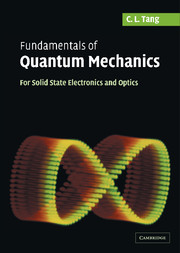Book contents
- Frontmatter
- Contents
- Preface
- 1 Classical mechanics vs. quantum mechanics
- 2 Basic postulates and mathematical tools
- 3 Wave/particle duality and de Broglie waves
- 4 Particles at boundaries, potential steps, barriers, and in quantum wells
- 5 The harmonic oscillator and photons
- 6 The hydrogen atom
- 7 Multi-electron ions and the periodic table
- 8 Interaction of atoms with electromagnetic radiation
- 9 Simple molecular orbitals and crystalline structures
- 10 Electronic properties of semiconductors and the p-n junction
- 11 The density matrix and the quantum mechanic Boltzmann equation
- References
- Index
10 - Electronic properties of semiconductors and the p-n junction
Published online by Cambridge University Press: 05 June 2012
- Frontmatter
- Contents
- Preface
- 1 Classical mechanics vs. quantum mechanics
- 2 Basic postulates and mathematical tools
- 3 Wave/particle duality and de Broglie waves
- 4 Particles at boundaries, potential steps, barriers, and in quantum wells
- 5 The harmonic oscillator and photons
- 6 The hydrogen atom
- 7 Multi-electron ions and the periodic table
- 8 Interaction of atoms with electromagnetic radiation
- 9 Simple molecular orbitals and crystalline structures
- 10 Electronic properties of semiconductors and the p-n junction
- 11 The density matrix and the quantum mechanic Boltzmann equation
- References
- Index
Summary
Some of the most important applications of quantum mechanics are in semiconductor physics and technology based on the properties of electrons in a periodic lattice of ions. This problem is discussed on the basis of the nearly-free-electron model of the crystalline solids in this chapter. In this model, the entire solid is represented by a quantum well of macroscopic dimensions. The spatially-varying electron potential due to the periodic lattice of ions inside the well is considered a perturbation on the free-electron states leading to the Bloch states and the band structure of the semiconductor. The concepts of effective mass and group velocity of the electrons and holes in the conduction and valence bands separated by an energy-gap are introduced. The electrons and holes are distributed over the available Bloch states in these bands depending on the location of the Fermi level according to Fermi statistics. The transport properties of these charge-carriers and their influence on the electrical conductivity of the semiconductor are discussed. When impurities are present, the electrical properties can be drastically altered, resulting in n-type and p-type semiconductors. The p–n junction is a key element in modern semiconductor electronic and photonic devices.
Molecular orbital picture of the valence and conduction bands of semiconductors
Atoms can be brought together to form crystalline solids through a variety of mechanisms. Most of the commonly used semiconductors are partially covalently and partially ionically bonded crystals of diamond or zincblende structure.
Information
- Type
- Chapter
- Information
- Fundamentals of Quantum MechanicsFor Solid State Electronics and Optics, pp. 151 - 181Publisher: Cambridge University PressPrint publication year: 2005
